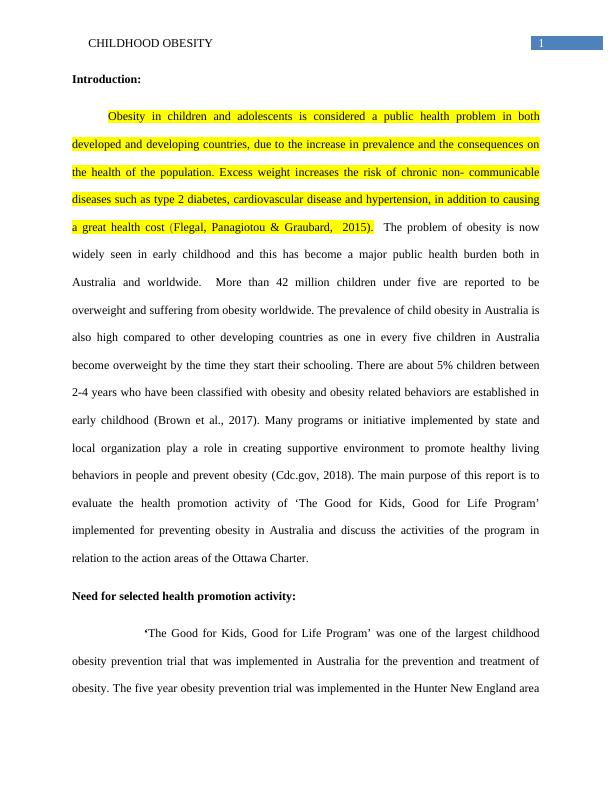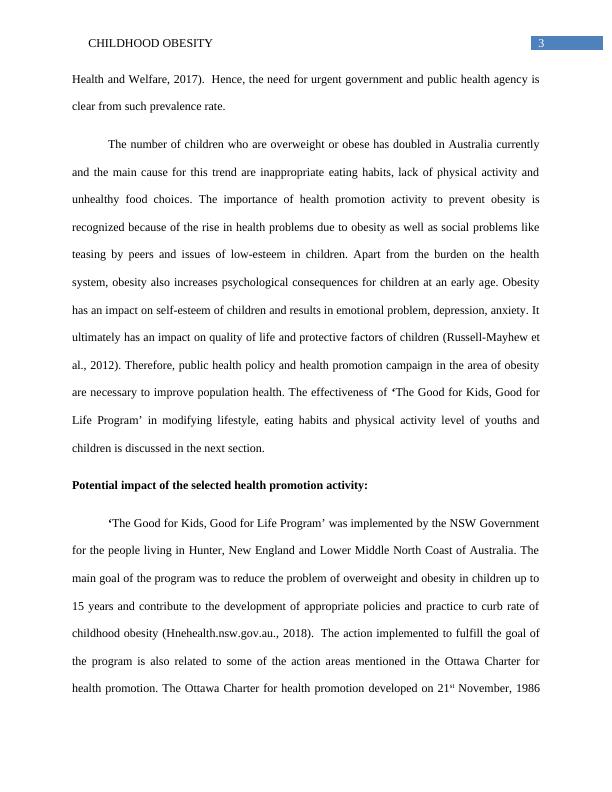Childhood obesity - Assignment PDF
13 Pages3628 Words39 Views
Added on 2021-04-17
Childhood obesity - Assignment PDF
Added on 2021-04-17
ShareRelated Documents
Running head: CHILDHOOD OBESITY
Childhood obesity
Name of the student:
Name of the University:
Author’s note
Childhood obesity
Name of the student:
Name of the University:
Author’s note

1CHILDHOOD OBESITY
Introduction:
Obesity in children and adolescents is considered a public health problem in both
developed and developing countries, due to the increase in prevalence and the consequences on
the health of the population. Excess weight increases the risk of chronic non- communicable
diseases such as type 2 diabetes, cardiovascular disease and hypertension, in addition to causing
a great health cost (Flegal, Panagiotou & Graubard, 2015). The problem of obesity is now
widely seen in early childhood and this has become a major public health burden both in
Australia and worldwide. More than 42 million children under five are reported to be
overweight and suffering from obesity worldwide. The prevalence of child obesity in Australia is
also high compared to other developing countries as one in every five children in Australia
become overweight by the time they start their schooling. There are about 5% children between
2-4 years who have been classified with obesity and obesity related behaviors are established in
early childhood (Brown et al., 2017). Many programs or initiative implemented by state and
local organization play a role in creating supportive environment to promote healthy living
behaviors in people and prevent obesity (Cdc.gov, 2018). The main purpose of this report is to
evaluate the health promotion activity of ‘The Good for Kids, Good for Life Program’
implemented for preventing obesity in Australia and discuss the activities of the program in
relation to the action areas of the Ottawa Charter.
Need for selected health promotion activity:
‘The Good for Kids, Good for Life Program’ was one of the largest childhood
obesity prevention trial that was implemented in Australia for the prevention and treatment of
obesity. The five year obesity prevention trial was implemented in the Hunter New England area
Introduction:
Obesity in children and adolescents is considered a public health problem in both
developed and developing countries, due to the increase in prevalence and the consequences on
the health of the population. Excess weight increases the risk of chronic non- communicable
diseases such as type 2 diabetes, cardiovascular disease and hypertension, in addition to causing
a great health cost (Flegal, Panagiotou & Graubard, 2015). The problem of obesity is now
widely seen in early childhood and this has become a major public health burden both in
Australia and worldwide. More than 42 million children under five are reported to be
overweight and suffering from obesity worldwide. The prevalence of child obesity in Australia is
also high compared to other developing countries as one in every five children in Australia
become overweight by the time they start their schooling. There are about 5% children between
2-4 years who have been classified with obesity and obesity related behaviors are established in
early childhood (Brown et al., 2017). Many programs or initiative implemented by state and
local organization play a role in creating supportive environment to promote healthy living
behaviors in people and prevent obesity (Cdc.gov, 2018). The main purpose of this report is to
evaluate the health promotion activity of ‘The Good for Kids, Good for Life Program’
implemented for preventing obesity in Australia and discuss the activities of the program in
relation to the action areas of the Ottawa Charter.
Need for selected health promotion activity:
‘The Good for Kids, Good for Life Program’ was one of the largest childhood
obesity prevention trial that was implemented in Australia for the prevention and treatment of
obesity. The five year obesity prevention trial was implemented in the Hunter New England area

2CHILDHOOD OBESITY
service from 2006-2011 and the main purpose was to prevent obesity and overweight in children
from 0-15 years of age. It was part of NSW’s ‘Live Life Well’ initiative and influenced services
and programs to prevent obesity (Hnehealth.nsw.gov.au. 2018). The need for such kind of health
promotion activity arose after the acceleration of the rate of obesity in children with time. The
rate of child obesity in Australia increased from 5% in 1995 to 8% in 2007-2008 and the
Australian government also announced the need to develop health promotion activities related to
healthy eating and physical activity guideline (Abs.gov.au. 2009). Changes in lifestyle and
sedentary living have been the main reason for teenagers and youths in Australia to become
obese. Evident also suggest that diet, physical activity and sedentary behavior are modifiable
determinants of obesity and these factors interact in a complex way and contribute to overweight
and obesity (Leech, McNaughton & Timperio, 2014). Hence, ‘The Good for Kids, Good for Life
Program’ was implemented to change eating habits of children and promote physical activity and
create opportunities for children and families to lead a healthy life.
Obesity is a systemic, chronic and multifactorial disease involving genetic susceptibility
and lifestyles and the environment, influenced by various underlying determinants, such as
globalization, culture, economic condition, education, urbanization and the political and social
environments. Obesity can reduce the life expectancy of people in up to 8 years and in 19 years
of life without diseases, according to a study published today in the medical journal. It is
considered that a BMI below 18.5 indicates malnutrition or some health problem, while one over
25 indicates overweight. Above 30 there is mild obesity, and above 40 there is high obesity
(Barbour, 2011). The review of current statistics for obesity in children and youth revealed that
one in every four Australian children were overweight or obesity in 2014-2017 and overweight
and obesity was attributable for 5% of the burden of disease in 2011 (Australian Institute of
service from 2006-2011 and the main purpose was to prevent obesity and overweight in children
from 0-15 years of age. It was part of NSW’s ‘Live Life Well’ initiative and influenced services
and programs to prevent obesity (Hnehealth.nsw.gov.au. 2018). The need for such kind of health
promotion activity arose after the acceleration of the rate of obesity in children with time. The
rate of child obesity in Australia increased from 5% in 1995 to 8% in 2007-2008 and the
Australian government also announced the need to develop health promotion activities related to
healthy eating and physical activity guideline (Abs.gov.au. 2009). Changes in lifestyle and
sedentary living have been the main reason for teenagers and youths in Australia to become
obese. Evident also suggest that diet, physical activity and sedentary behavior are modifiable
determinants of obesity and these factors interact in a complex way and contribute to overweight
and obesity (Leech, McNaughton & Timperio, 2014). Hence, ‘The Good for Kids, Good for Life
Program’ was implemented to change eating habits of children and promote physical activity and
create opportunities for children and families to lead a healthy life.
Obesity is a systemic, chronic and multifactorial disease involving genetic susceptibility
and lifestyles and the environment, influenced by various underlying determinants, such as
globalization, culture, economic condition, education, urbanization and the political and social
environments. Obesity can reduce the life expectancy of people in up to 8 years and in 19 years
of life without diseases, according to a study published today in the medical journal. It is
considered that a BMI below 18.5 indicates malnutrition or some health problem, while one over
25 indicates overweight. Above 30 there is mild obesity, and above 40 there is high obesity
(Barbour, 2011). The review of current statistics for obesity in children and youth revealed that
one in every four Australian children were overweight or obesity in 2014-2017 and overweight
and obesity was attributable for 5% of the burden of disease in 2011 (Australian Institute of

3CHILDHOOD OBESITY
Health and Welfare, 2017). Hence, the need for urgent government and public health agency is
clear from such prevalence rate.
The number of children who are overweight or obese has doubled in Australia currently
and the main cause for this trend are inappropriate eating habits, lack of physical activity and
unhealthy food choices. The importance of health promotion activity to prevent obesity is
recognized because of the rise in health problems due to obesity as well as social problems like
teasing by peers and issues of low-esteem in children. Apart from the burden on the health
system, obesity also increases psychological consequences for children at an early age. Obesity
has an impact on self-esteem of children and results in emotional problem, depression, anxiety. It
ultimately has an impact on quality of life and protective factors of children (Russell-Mayhew et
al., 2012). Therefore, public health policy and health promotion campaign in the area of obesity
are necessary to improve population health. The effectiveness of ‘The Good for Kids, Good for
Life Program’ in modifying lifestyle, eating habits and physical activity level of youths and
children is discussed in the next section.
Potential impact of the selected health promotion activity:
‘The Good for Kids, Good for Life Program’ was implemented by the NSW Government
for the people living in Hunter, New England and Lower Middle North Coast of Australia. The
main goal of the program was to reduce the problem of overweight and obesity in children up to
15 years and contribute to the development of appropriate policies and practice to curb rate of
childhood obesity (Hnehealth.nsw.gov.au., 2018). The action implemented to fulfill the goal of
the program is also related to some of the action areas mentioned in the Ottawa Charter for
health promotion. The Ottawa Charter for health promotion developed on 21st November, 1986
Health and Welfare, 2017). Hence, the need for urgent government and public health agency is
clear from such prevalence rate.
The number of children who are overweight or obese has doubled in Australia currently
and the main cause for this trend are inappropriate eating habits, lack of physical activity and
unhealthy food choices. The importance of health promotion activity to prevent obesity is
recognized because of the rise in health problems due to obesity as well as social problems like
teasing by peers and issues of low-esteem in children. Apart from the burden on the health
system, obesity also increases psychological consequences for children at an early age. Obesity
has an impact on self-esteem of children and results in emotional problem, depression, anxiety. It
ultimately has an impact on quality of life and protective factors of children (Russell-Mayhew et
al., 2012). Therefore, public health policy and health promotion campaign in the area of obesity
are necessary to improve population health. The effectiveness of ‘The Good for Kids, Good for
Life Program’ in modifying lifestyle, eating habits and physical activity level of youths and
children is discussed in the next section.
Potential impact of the selected health promotion activity:
‘The Good for Kids, Good for Life Program’ was implemented by the NSW Government
for the people living in Hunter, New England and Lower Middle North Coast of Australia. The
main goal of the program was to reduce the problem of overweight and obesity in children up to
15 years and contribute to the development of appropriate policies and practice to curb rate of
childhood obesity (Hnehealth.nsw.gov.au., 2018). The action implemented to fulfill the goal of
the program is also related to some of the action areas mentioned in the Ottawa Charter for
health promotion. The Ottawa Charter for health promotion developed on 21st November, 1986

End of preview
Want to access all the pages? Upload your documents or become a member.
Related Documents
Health Promotion: Munch and Move Intervention Among Childrenlg...
|17
|4498
|411
Health Promotion Campaignlg...
|10
|2753
|68
Health Promotion Approaches for Child Obesity by Nursinglg...
|12
|4153
|163
Go4Fun Health Program for Childhood Obesity in NSWlg...
|13
|3160
|312
Child Obesity: Public Health Strategies, Health Promotion, and Role of Nurseslg...
|1
|997
|452
Obesity: A Global Public Health Issuelg...
|11
|807
|153
